A Proton Battery Stack Real-Time Monitor with a Flexible Six-in-One Microsensor
Abstract
:1. Introduction
2. Sensing Principle of Flexible Six-in-One Microsensor
2.1. Principle of Hydrogen Microsensor
2.2. Principle of Temperature Microsensor
2.3. Principle of Humidity Microsensor
2.4. Principle of Flow Microsensor
2.5. Principle of Voltage and Current Microsensor
3. Process Development of Flexible Six-in-One Microsensor
- (a)
- The PI film was first cleaned with an organic solution of acetone and methanol and used the ultrasonic shaker to shake and wash for three minutes. In order to remove surface dust and residual grease and increase the adhesion of the membrane metal, and the residual methanol was removed with deionized water and baked on a hot plate.
- (b)
- Then, an electron beam evaporator (EBS-500, Junsun technologies Co., Taipei, Taiwan) was used to deposit chromium and gold. The advantages of deposit are excellent coating adhesion and easily tunable microstructure [26], as well as fast deposition rates and high throughput per pass. Due to the insufficient adhesion of the gold vapor deposited on the PI film, it is easy to cause the gold to fall off. Therefore, chromium is used as an adhesion layer to reduce gold falling off.
- (c)
- The patterns of micro hydrogen, temperature, voltage, current, flow, and humidity sensors were defined using photolithography. Photolithography is a process that takes advantage of the decomposition of the photosensitive part of the positive photoresist, and this study uses AZ® P4620 positive photoresist. First, a spin coater is used to apply the positive photoresist evenly to the substrate. It is then placed on a mask aligner and exposure system (AG-200-4N-D-SM, M&R Nano Technology Co., Taoyuan, Taiwan) with a flexible six-in-one micro-sensor photomask for exposure. The light-transmitting part of the photomask allows UV light to pass through the machine, while the part of the positive photoresist exposed to UV light will be removed. After three minutes of development, the photolithography process was completed, and a complete pattern was obtained. The developer used in this experiment is AZ® 400K.
- (d)
- Wet etching was conducted with AG-835 gold etchant and Cr-7T chromium etchant to remove the metal not covered by photoresist.
- (e)
- A photoresist was reapplied to define the pattern of the hydrogen microsensor, the tin dioxide and platinum were sputtered on the hydrogen microsensor, and the photomask was removed.
- (f)
- LTC 9320 was applied as a protective coating. Then, the sensing areas and pins of the voltage, current, and humidity microsensors were redefined using the photolithography process to leave them exposed and not covered by a protective layer.
- (g)
- Finally, a coat of LTC 9305 was applied as the humidity sensing film of the humidity microsensor to complete the manufacturing process of the flexible six-in-one microsensor.
4. Calibration of Flexible Six-in-One Microsensor
4.1. Hydrogen Calibration of Flexible Six-in-One Microsensor
4.2. Temperature Calibration of Flexible Six-in-One Microsensor
4.3. Humidity Calibration of Flexible Six-in-One Microsensor
4.4. Flow Calibration of Flexible Six-in-One Microsensor
4.5. Voltage and Current Calibration of Flexible Six-in-One Microsensor
4.6. Accuracy of Calibration Machine
5. Internal Measurements of Proton Battery Stack
5.1. Internal Voltage and Current Measurement during Proton Stack Charging
5.2. Internal Temperature Measurement during Proton Battery Stack Charging
5.3. Internal Flow Measurement during Proton Battery Stack Charging
5.4. Internal Humidity Measurement during Proton Battery Stack Charging
5.5. Internal Hydrogen Measurement during Proton Battery Stack Charging
6. Improvement of Flexible Six-in-One Microsensor
7. Conclusions
Author Contributions
Funding
Acknowledgments
Conflicts of Interest
Nomenclature
| MEMS | Micro-electro-mechanical systems |
| GDL | Gas diffusion layer |
| ZIF-8 | Zeolitic imidazolate framework |
| BET | Brunauer–Emmet–Teller |
| CCHP | Combined cooling heating and power |
| PEMWE | Proton exchange membrane water electrolysis |
| PEMFC | Proton exchange membrane fuel cell |
| MEA | Membrane electrode assembly |
| PI | Polyimide |
| RTD | Resistance temperature detector |
| TCR | Temperature coefficient of resistance |
References
- Handayani, K.; Anugrah, P.; Goembira, F.; Overland, I.; Suryadi, B.; Swandaru, A. Moving beyond the NDCs: ASEAN pathways to a net-zero emissions power sector in 2050. Appl. Energy 2022, 311, 118580–118597. [Google Scholar] [CrossRef]
- Heidari, S.; Mohammadi, S.S.; Oberoi, A.S.; Andrews, J. Technical feasibility of a proton battery with an activated carbon electrode. Int. J. Hydrog. Energy 2018, 43, 6197–6209. [Google Scholar] [CrossRef]
- Kapoor, D.; Oberoi, A.S.; Nijhawan, P. Hydrogen production and subsequent adsorption/desorption process within a modified unitized regenerative fuel cell. Processes 2019, 7, 238. [Google Scholar] [CrossRef]
- Andrews, J.; Mohammadi, S.S. Towards a ‘proton flow battery’: Investigation of a reversible PEM fuel cell with integrated metal-hydride hydrogen storage. Int. J. Hydrog. Energy 2014, 39, 1740–1751. [Google Scholar] [CrossRef]
- Selembo, P.A.; Merrill, M.D.; Logan, B.E. Hydrogen production with nickel powder cathode catalysts in microbial electrolysis cells. Int. J. Hydrog. Energy 2010, 35, 428–437. [Google Scholar] [CrossRef]
- Zhou, Z.; Qiu, D.; Zhai, S.; Peng, L.; Lai, X. Investigation of the assembly for high-power proton exchange membrane fuel cell stacks through an efficient equivalent model. Appl. Energy 2020, 277, 115532–115541. [Google Scholar] [CrossRef]
- Arifin, N.F.T.; Yusof, N.; Nordin, N.A.H.M.; Jaafar, J.; Ismail, A.F.; Salleh, W.N.W.; Aziz, F. An improved hybrid nanocomposites of rice husk derived graphene (GRHA)/Zeolitic imidazolate framework-8 for hydrogen adsorption. J. Hydrog. Energy 2020, 46, 24864–24876. [Google Scholar] [CrossRef]
- Bosch, M.; Zhou, H.C. Porous carbons for hydrogen storage. Nanostruct. Mater. Next-Gener. Energy Storage Convers. 2016, 4, 171–202. [Google Scholar]
- Paul, B.; Andrews, J. PEM unitised reversible/regenerative hydrogen fuel cell systems: State of the art and technical challenges. Renew. Sustain. Energy Rev. 2017, 79, 585–599. [Google Scholar] [CrossRef]
- Doddathimmaiah, A.; Andrews, J. Theory modelling and performance measurement of unitised regenerative fuel cells. Int. J. Hydrog. Energy 2009, 34, 8157–8170. [Google Scholar] [CrossRef]
- Wang, Y.; Leung, D.Y.C.; Xuana, J.; Wang, H. A review on unitized regenerative fuel cell technologies, part-A: Unitized regenerative proton exchange membrane fuel cells. Renew. Sustain. Energy Rev. 2016, 65, 961–977. [Google Scholar] [CrossRef]
- Chakik, F.E.; Mikou, M.K.M. Effect of operating parameters on hydrogen production by electrolysis of water. Int. J. Hydrog. Energy 2017, 42, 25550–25557. [Google Scholar] [CrossRef]
- Chahartaghi, M.; Kharkeshi, B.A. Performance analysis of a combined cooling, heating and power system with PEM fuel cell as a prime move. Appl. Therm. Eng. 2018, 128, 805–817. [Google Scholar] [CrossRef]
- Ou, K.; Yuana, W.W.; Choi, M.; Yang, S.; Kim, Y.B. Performance increase for an open-cathode PEM fuel cell with humidity and temperature control. Electrochim. Acta 2018, 42, 432–446. [Google Scholar] [CrossRef]
- Sun, Z.; Shen, Y.; Yuan, C.; Li, X. Influence of contamination on measurement accuracy of the calorimetric air flow sensor. Measurement 2019, 145, 108–117. [Google Scholar] [CrossRef]
- Kaya, M.F.; Demir, N.; Rees, N.V.; Kharouf, A.E. Improving PEM water electrolyser’s performance by magnetic field application. Appl. Energy 2020, 264, 114721–114728. [Google Scholar] [CrossRef]
- Kim, Y.S.; Kim, D.K. Operating strategy for successful start-up in self-humidified polymer electrolyte membrane fuel-cell system. Appl. Therm. Eng. 2019, 152, 370–376. [Google Scholar] [CrossRef]
- Kandidayeni, M.; Macias, A.; Boulon, L.; Kelouwani, S. Investigating the impact of ageing and thermal management of a fuel cell system on energy management strategies. Appl. Energy 2020, 274, 115293–115304. [Google Scholar] [CrossRef]
- Lee, C.Y.; Chen, C.H.; Cheong, J.S.; Chien, Y.H.; Lin, Y.C. Flexible 5-in-1 microsensor embedded in the proton battery for real-time microscopic diagnosis. Membranes 2019, 11, 276. [Google Scholar] [CrossRef]
- Cirrone, D.; Shentsov, V.; Kashkarov, S.; Dadashzadeh, M.; Makarov, D.; Molkov, V. Deliverable 1.2 Report on Hydrogen Hazards and Risks in Tunnels and Similar Confined Spaces; CORDIS No. D1.2; Fuel Cells and Hydrogen Joint Undertaking: Brussels, Belgium, 2019. [Google Scholar]
- Wang, W.; Zhen, Y.; Zhang, J.; Li, Y.; Zhong, H.; Jia, Z.; Xiong, Y.; Xue, Q.; Yan, Y.; Alharbi, N.S.; et al. SnO2 nanoparticles-modified 3D-multilayer MoS2 nanosheets for ammonia gas sensing at room temperature. Sens. Actuators B 2020, 321, 128471–128481. [Google Scholar] [CrossRef]
- Abinaya, M.; Pal, R.; Sridharan, M. Highly sensitive room temperature hydrogen sensor based on undoped SnO2 thin film. Solid State Sci. 2019, 95, 105928–105933. [Google Scholar] [CrossRef]
- Deepu, B.R.; Venkatachalam, P.; Mirji, F.N.; Littin, V.; Naveen, H.; Savitha, P.; Basavaraju, Y.B. A surface micromachining: HNA etchant for stiction-free release of micro/nanomechanical structures. Mater. Today Proc. 2021, 42, 1218–1223. [Google Scholar] [CrossRef]
- Jewett, J.W.; Serway, J.R.A. Physics for Scientists and Engineers with Modern Physics, 8th ed.; Pearson: London, UK, 2014; Volume 776, pp. 780–781. [Google Scholar]
- Kiełbasa, J. The hot-wire anemometer. Arch. Min. Sci. 2014, 59, 467–475. [Google Scholar]
- Mundra, S.S.; Pardeshi, S.S.; Bhavikatti, S.S.; Nagras, A. Development of an integrated physical vapour deposition and chemical vapour deposition system. Mater. Today Proc. 2021, 46, 1229–1234. [Google Scholar] [CrossRef]

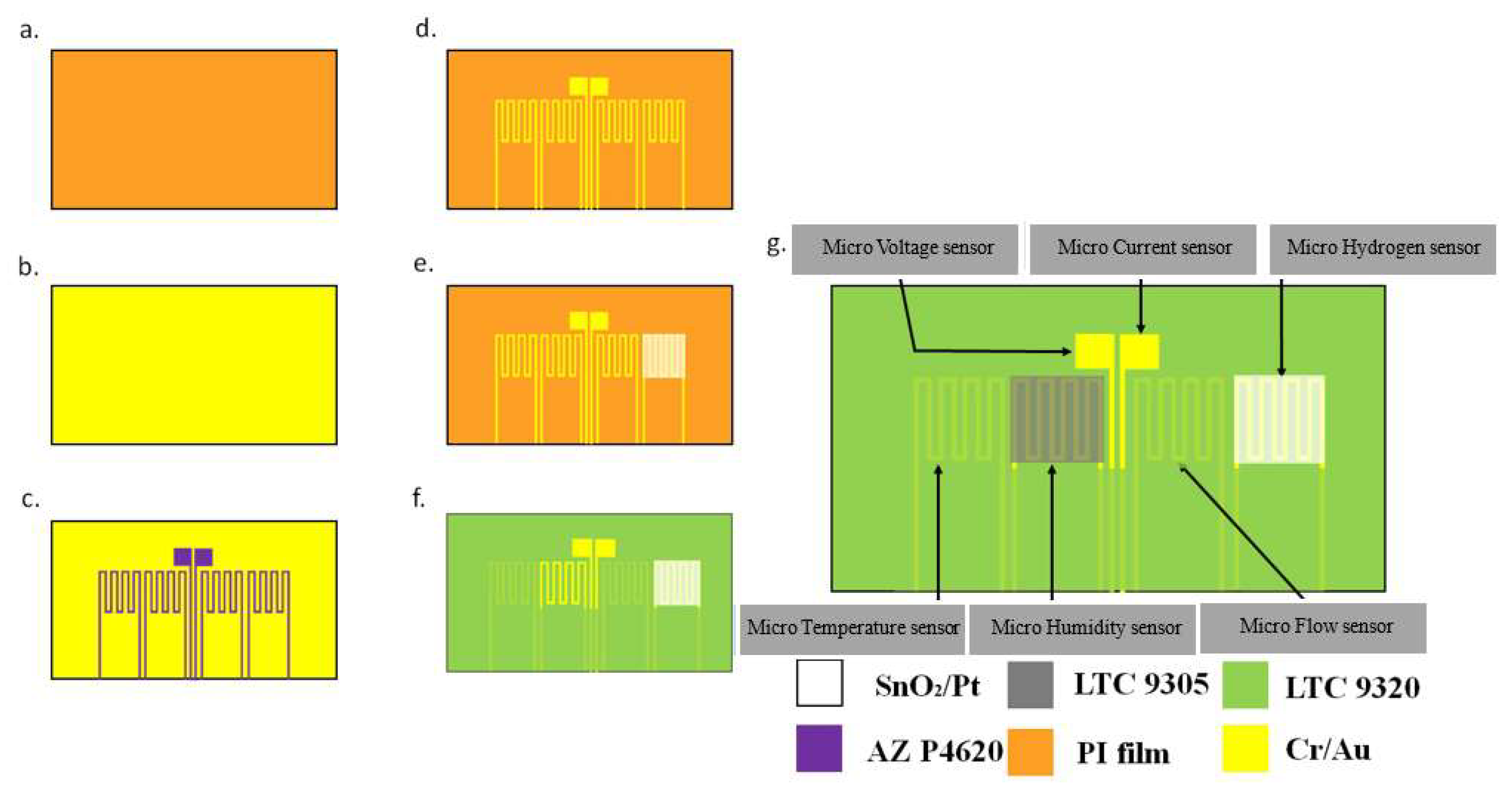
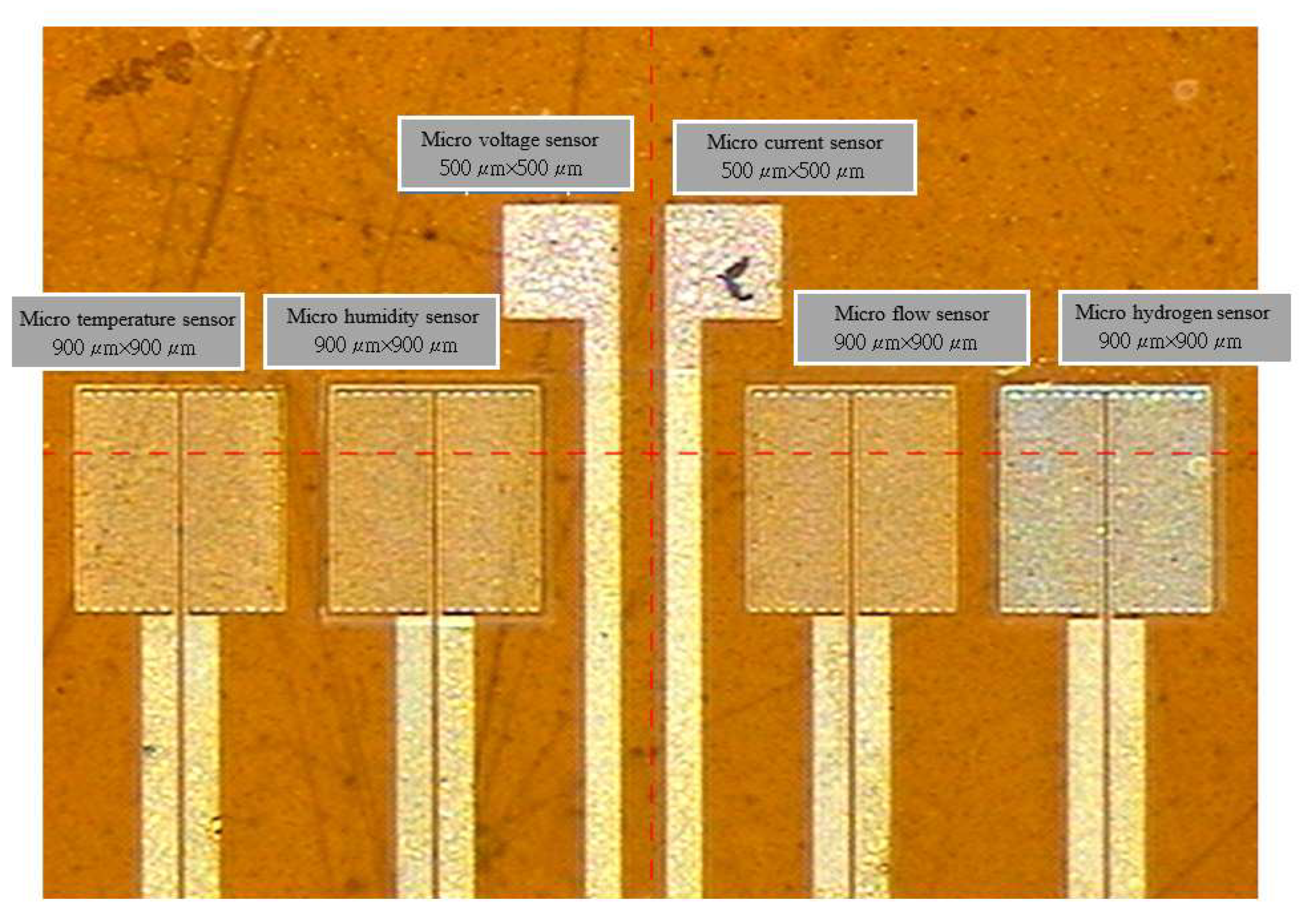
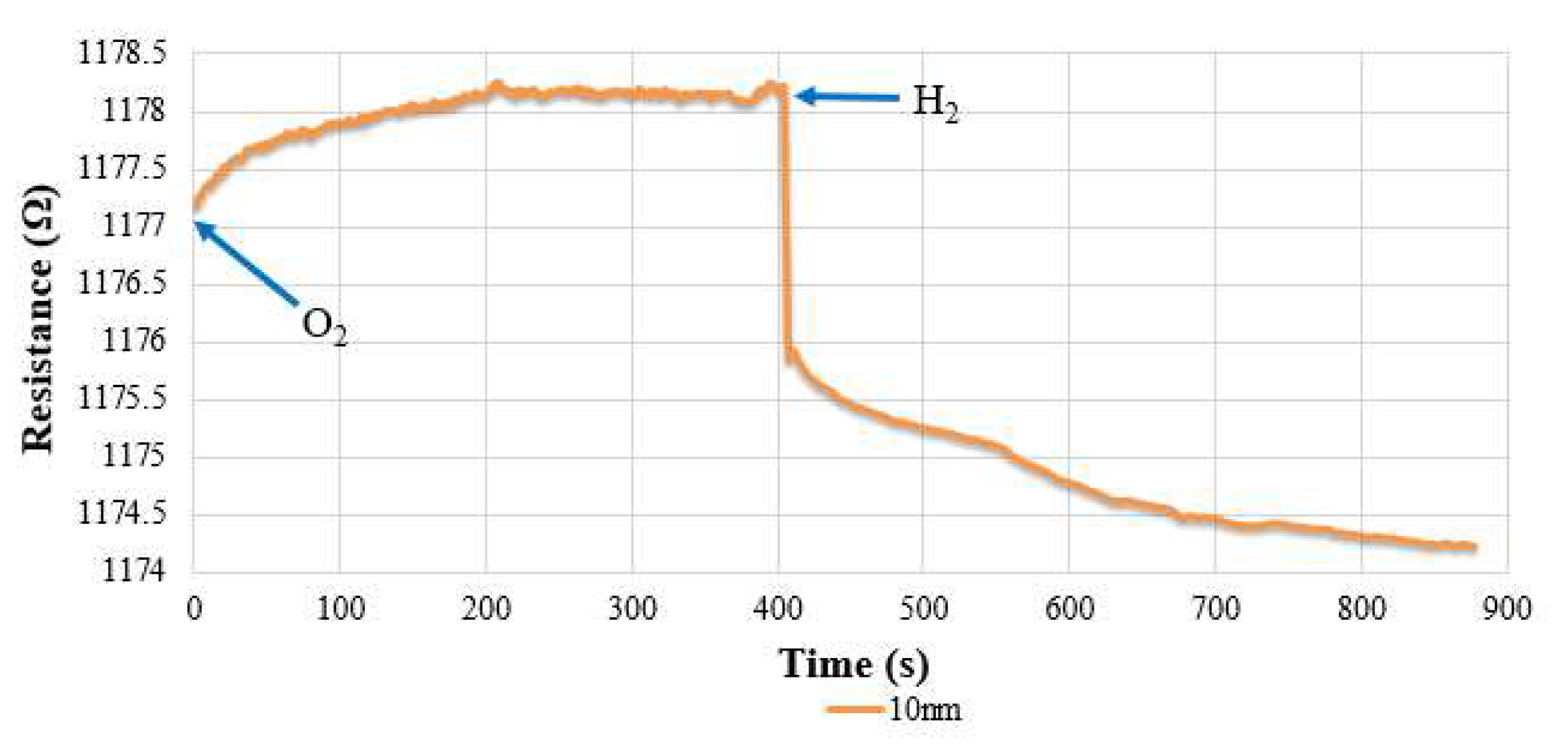

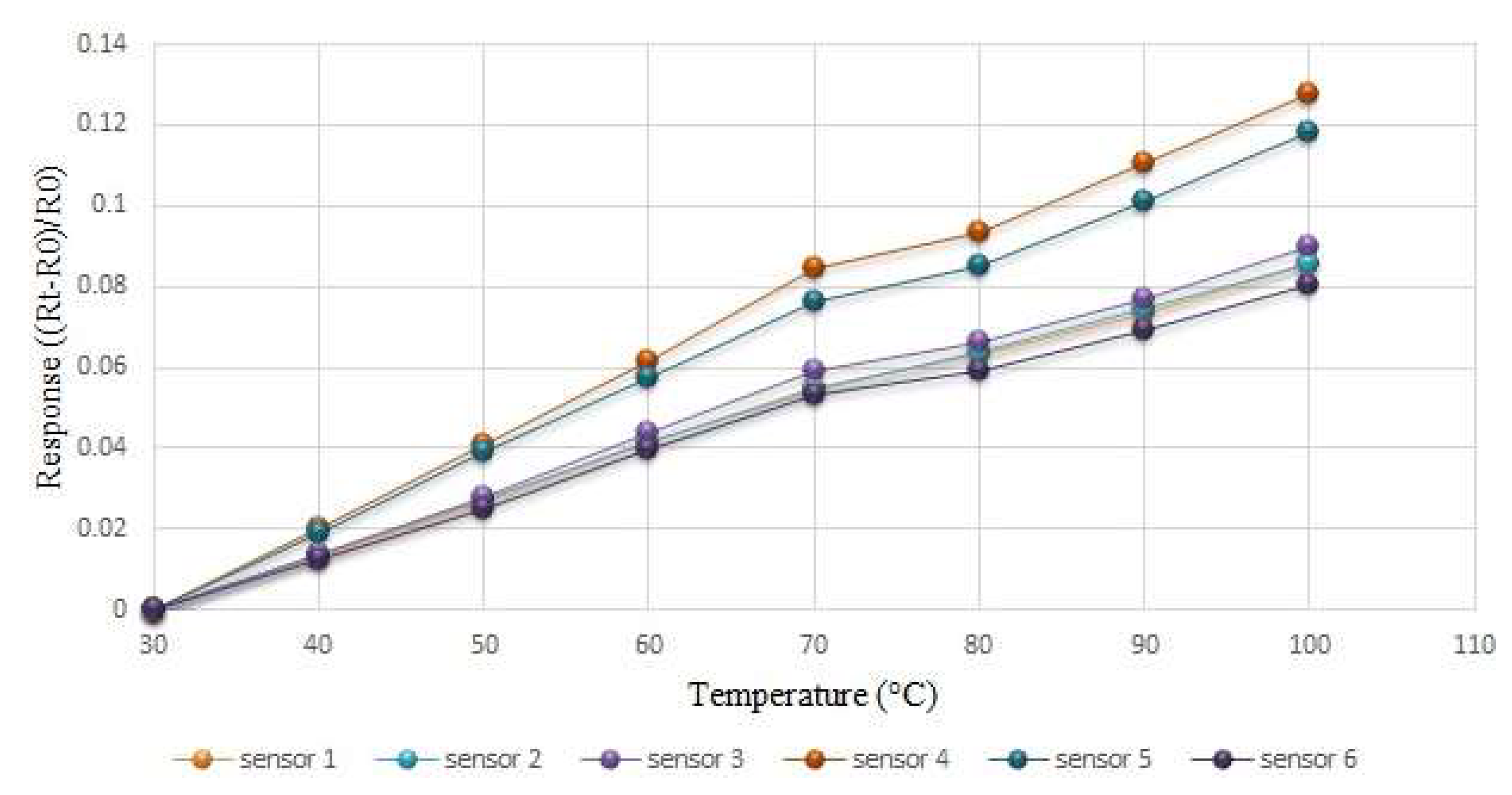
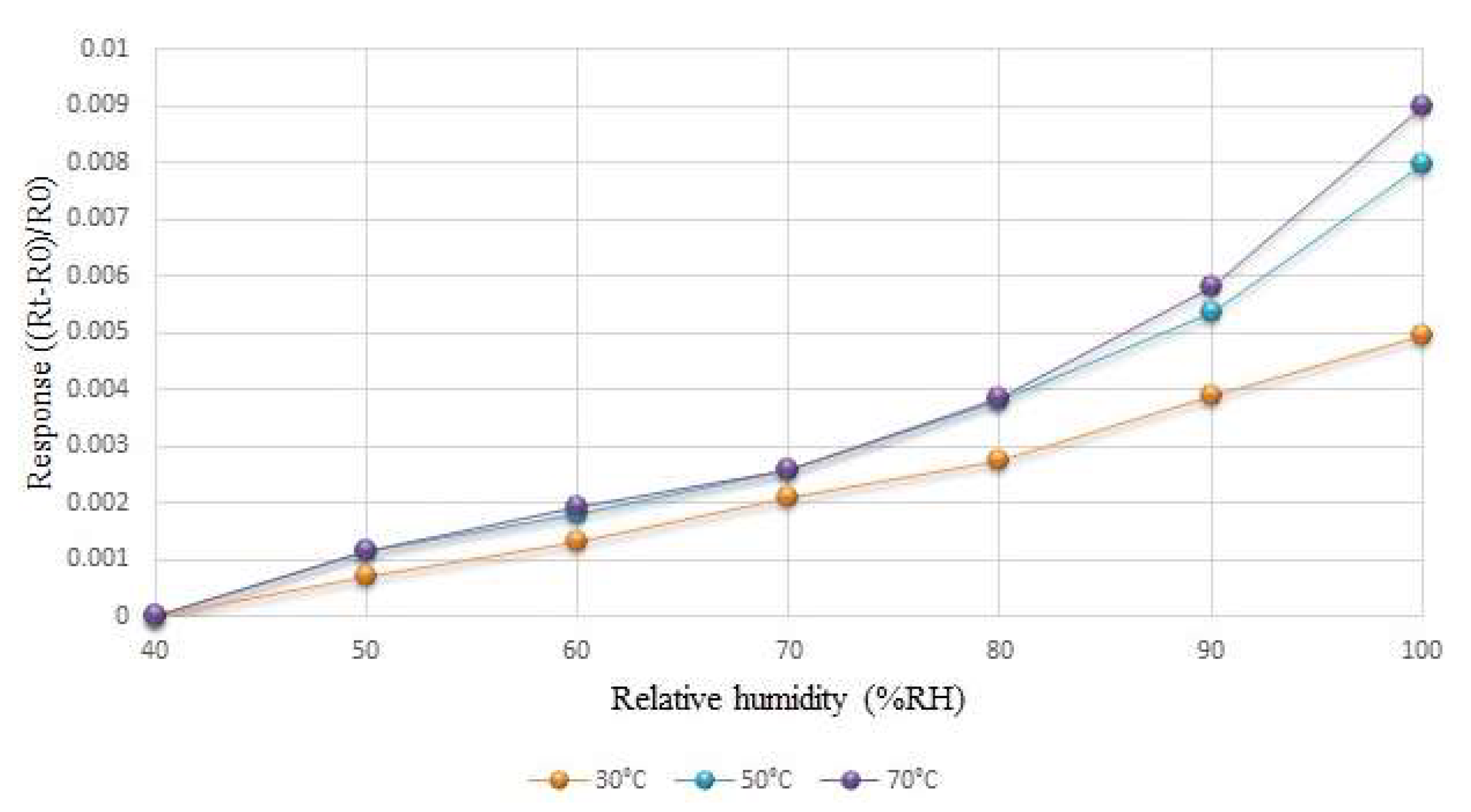
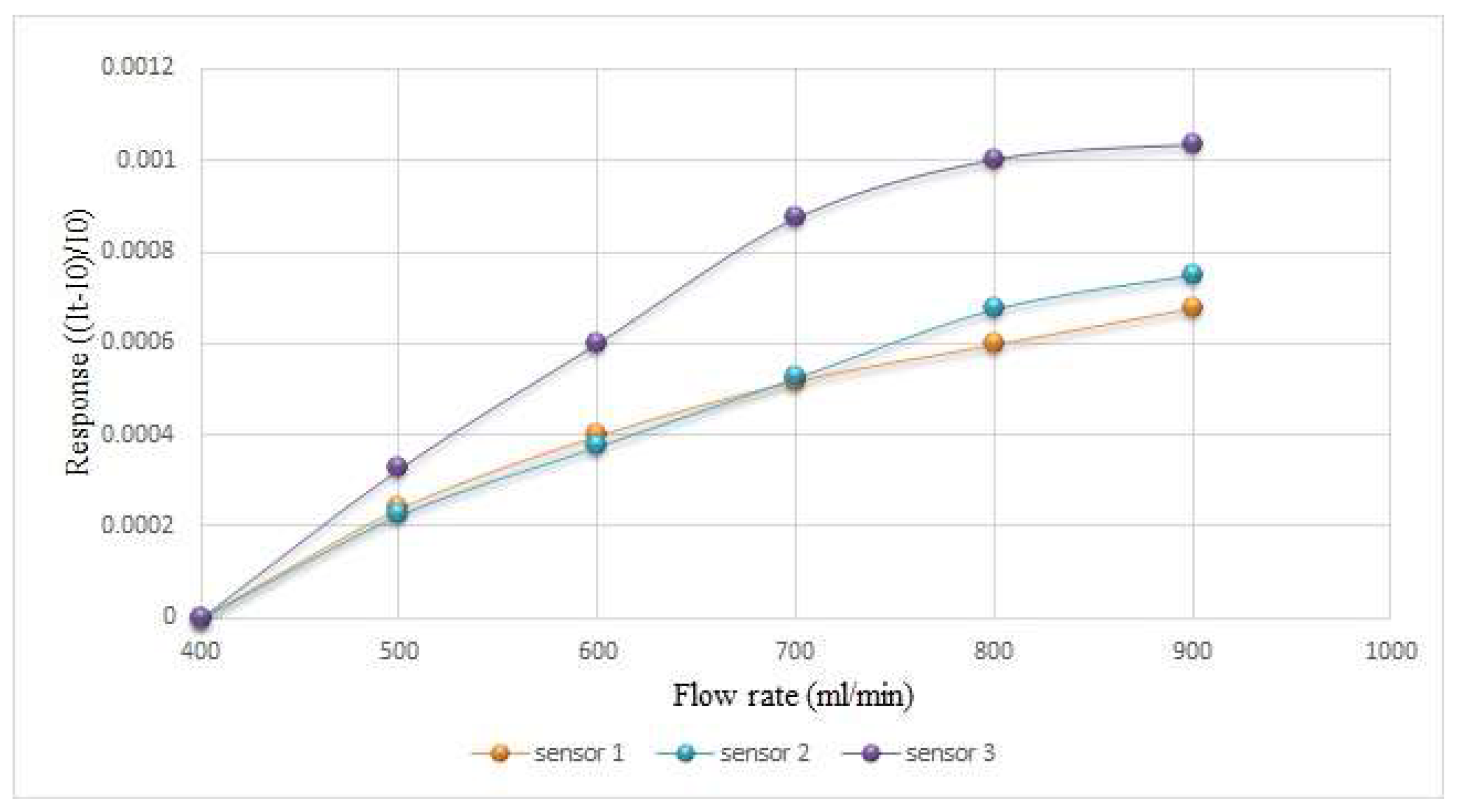
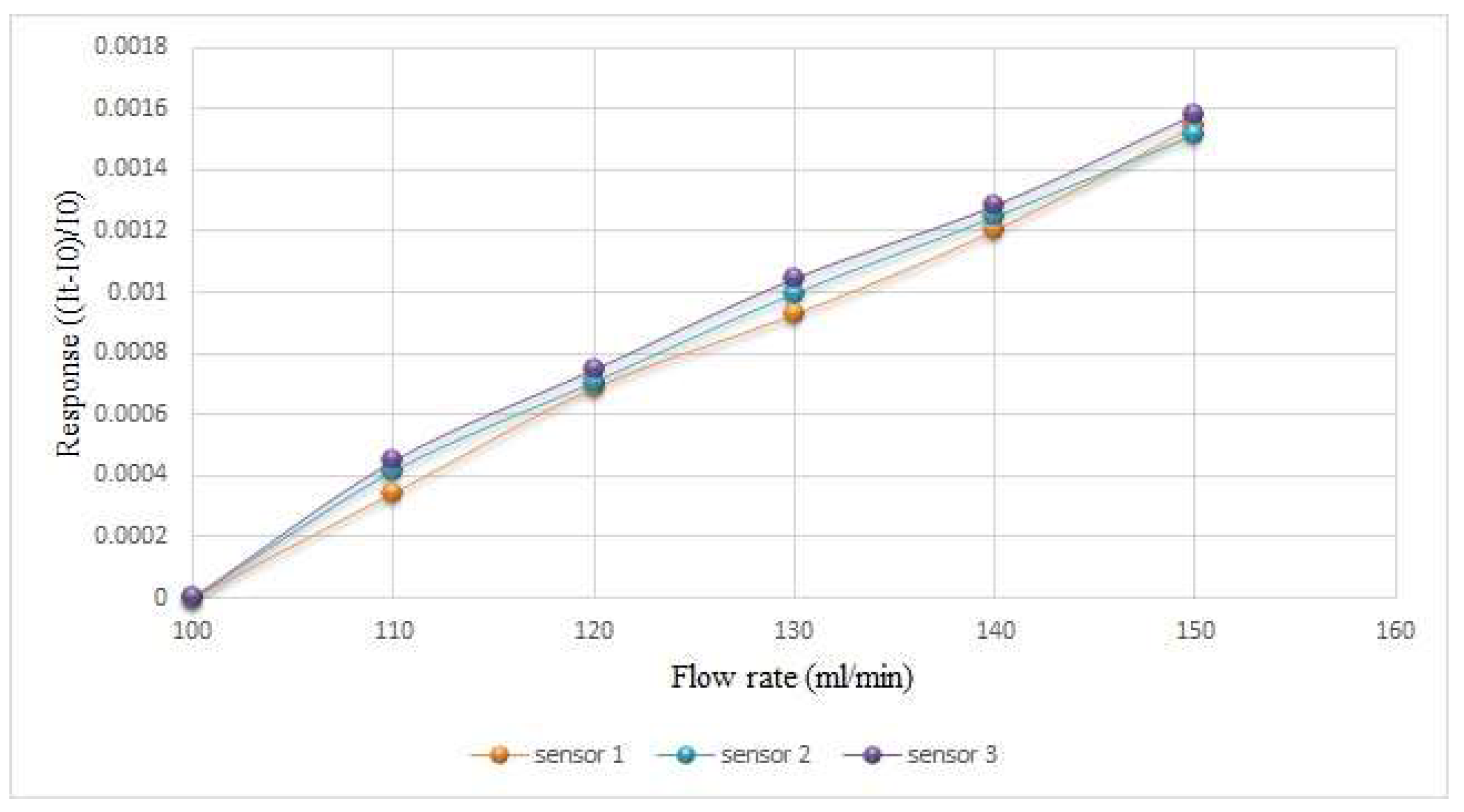
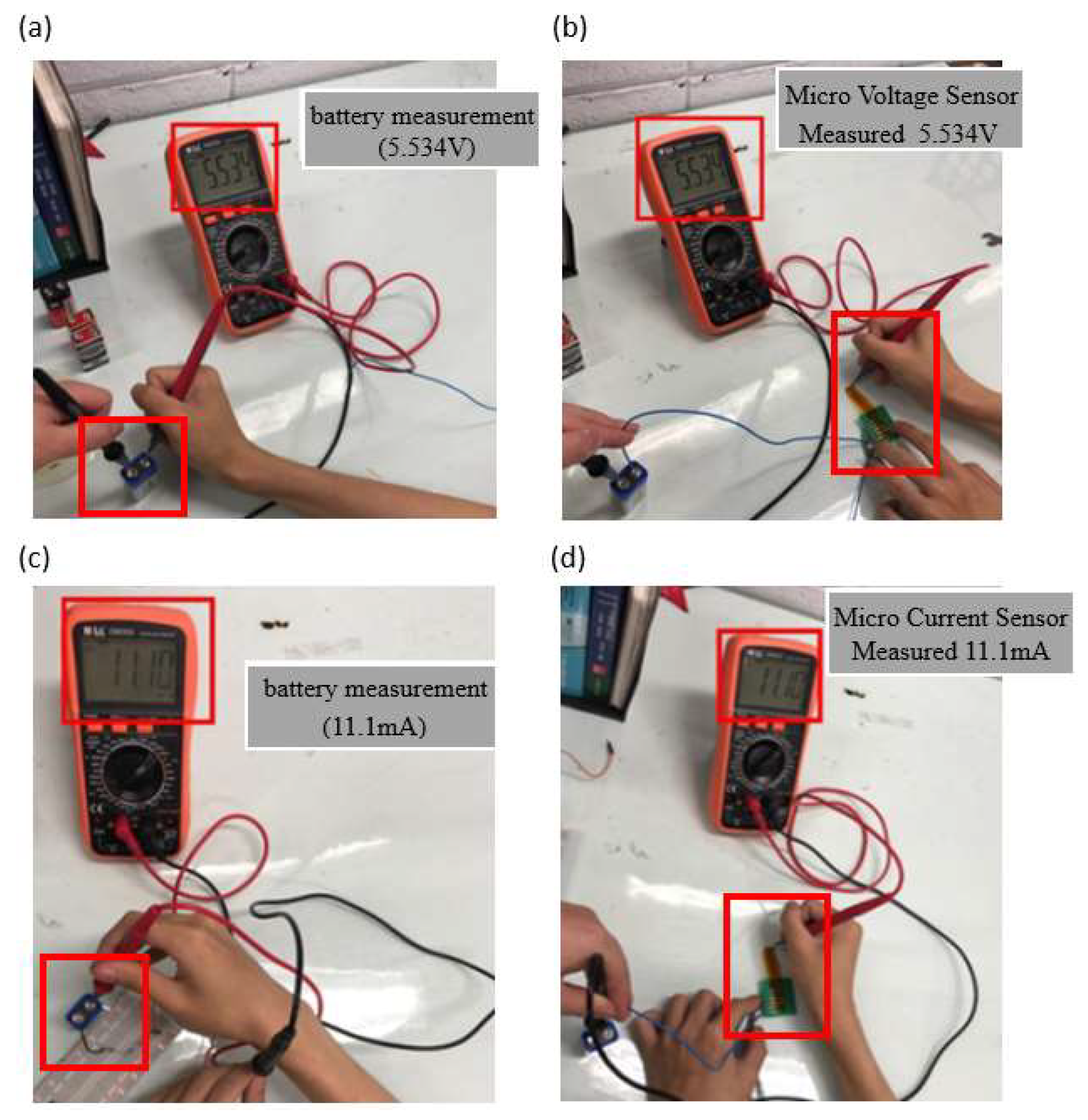
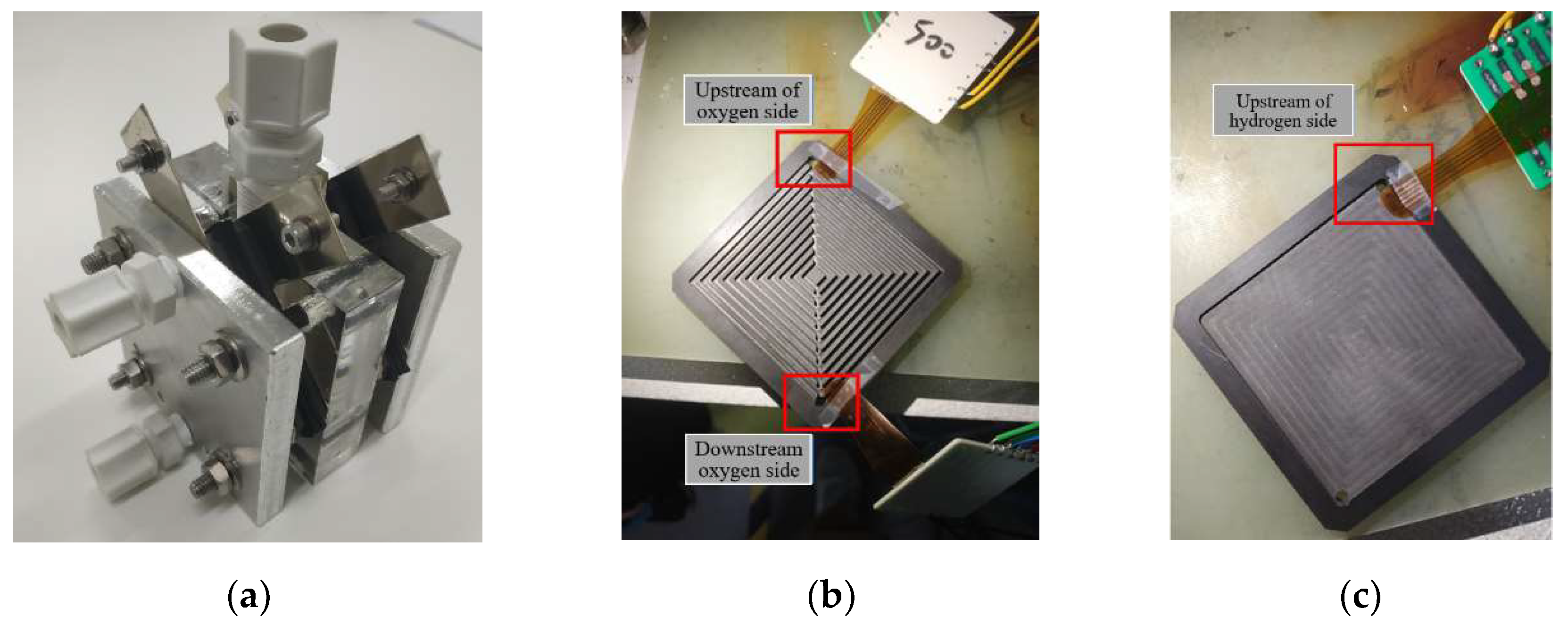
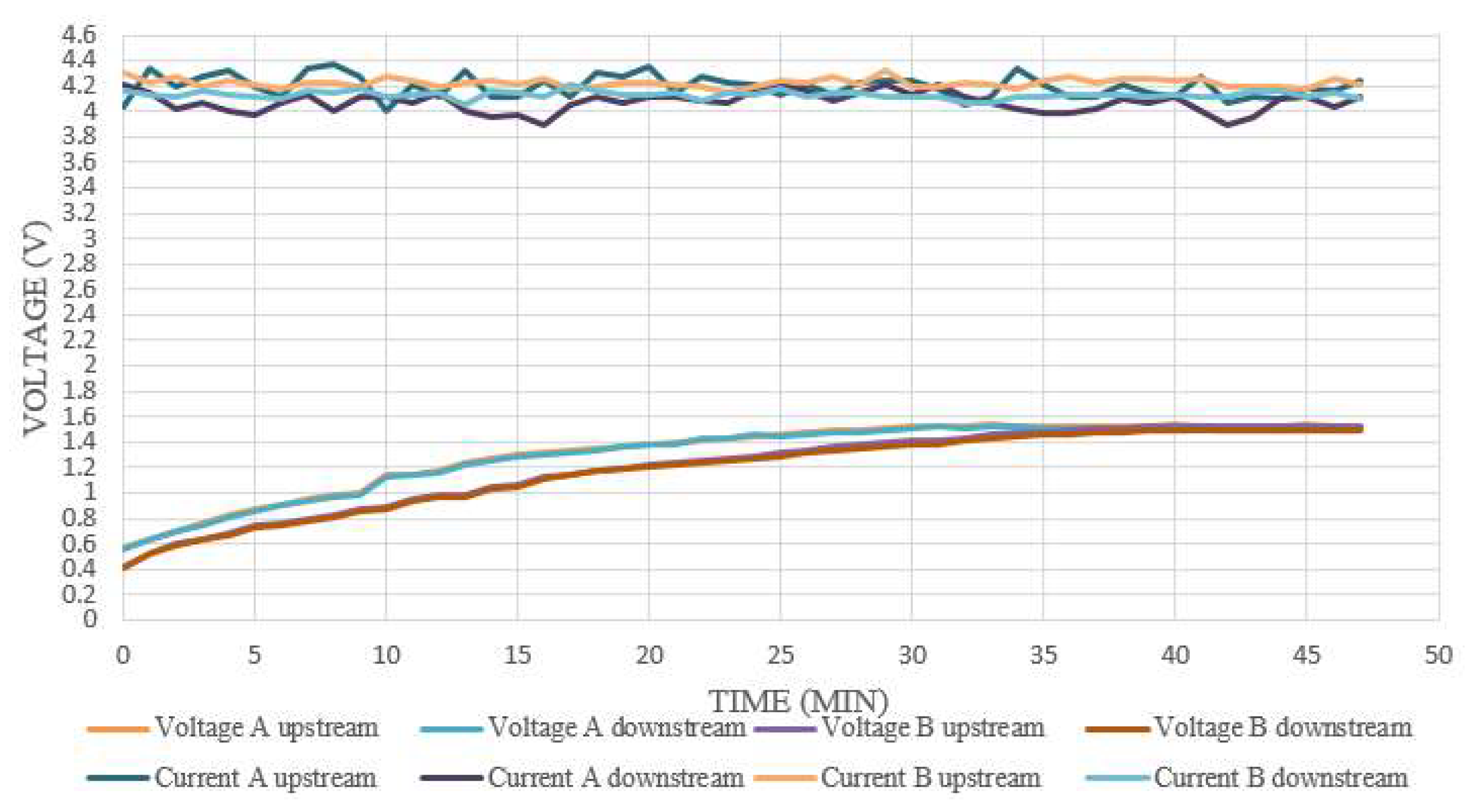
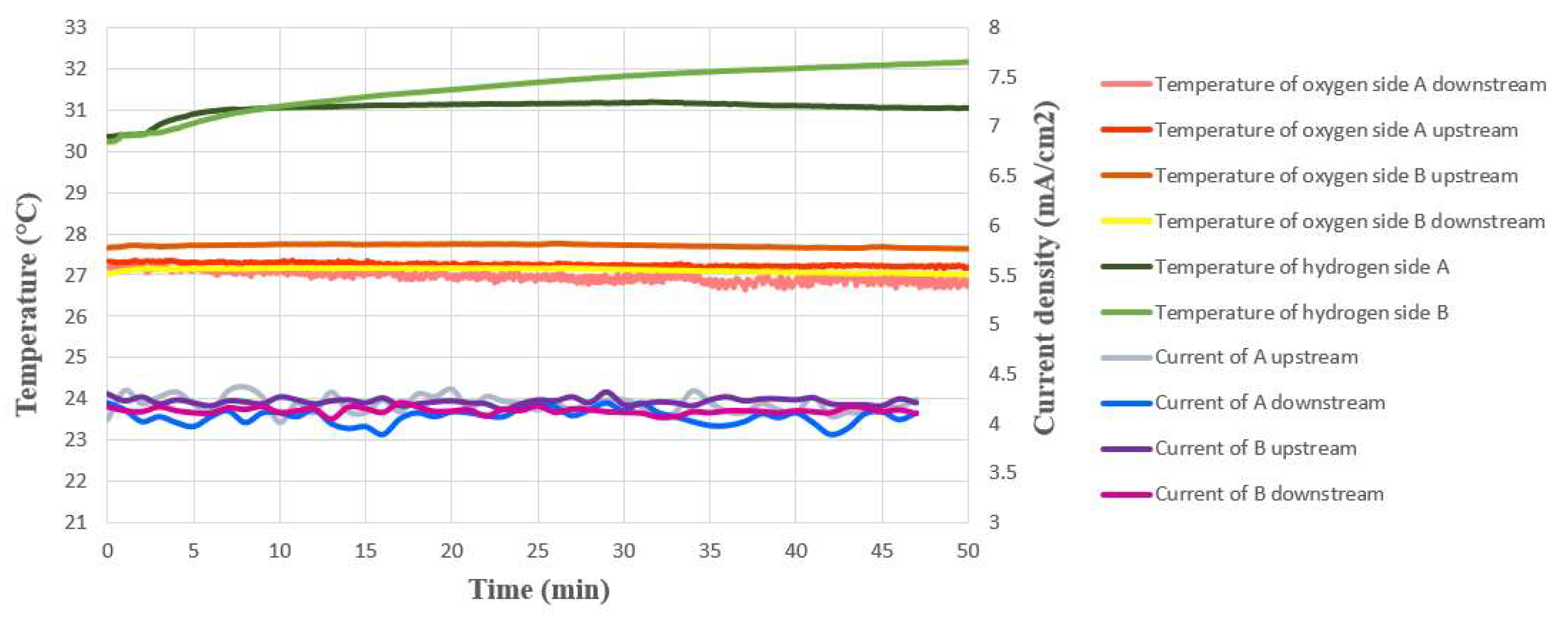
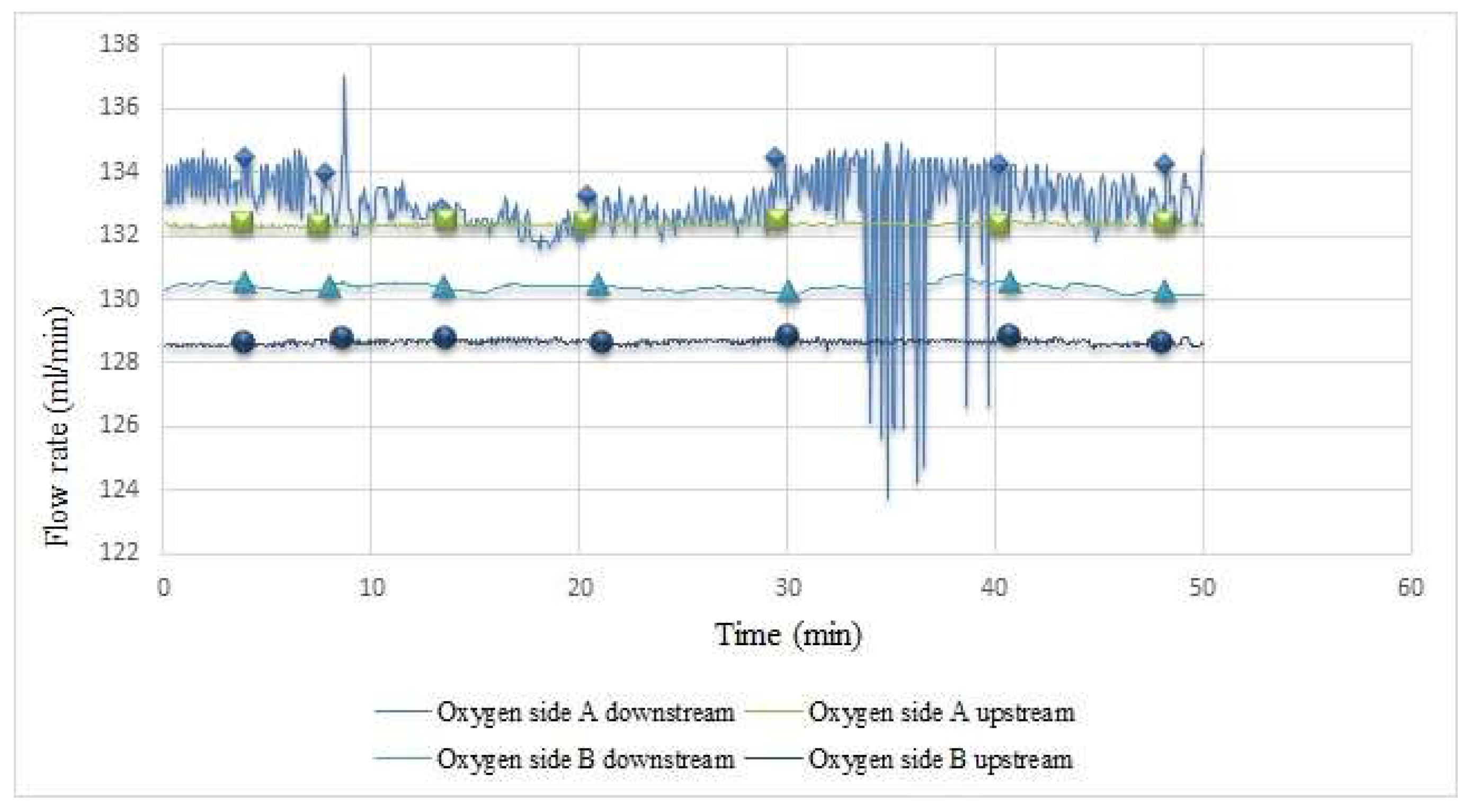
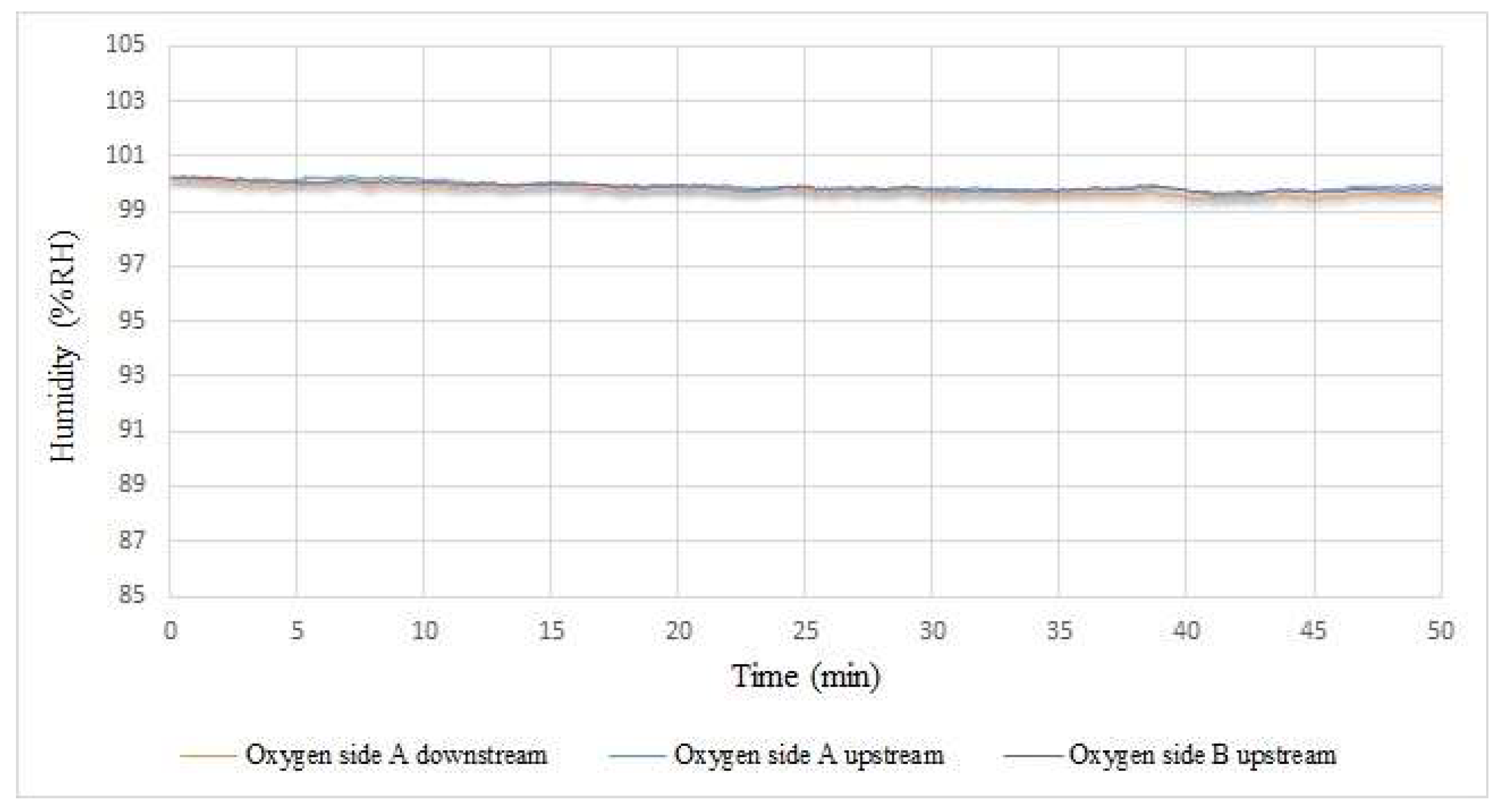
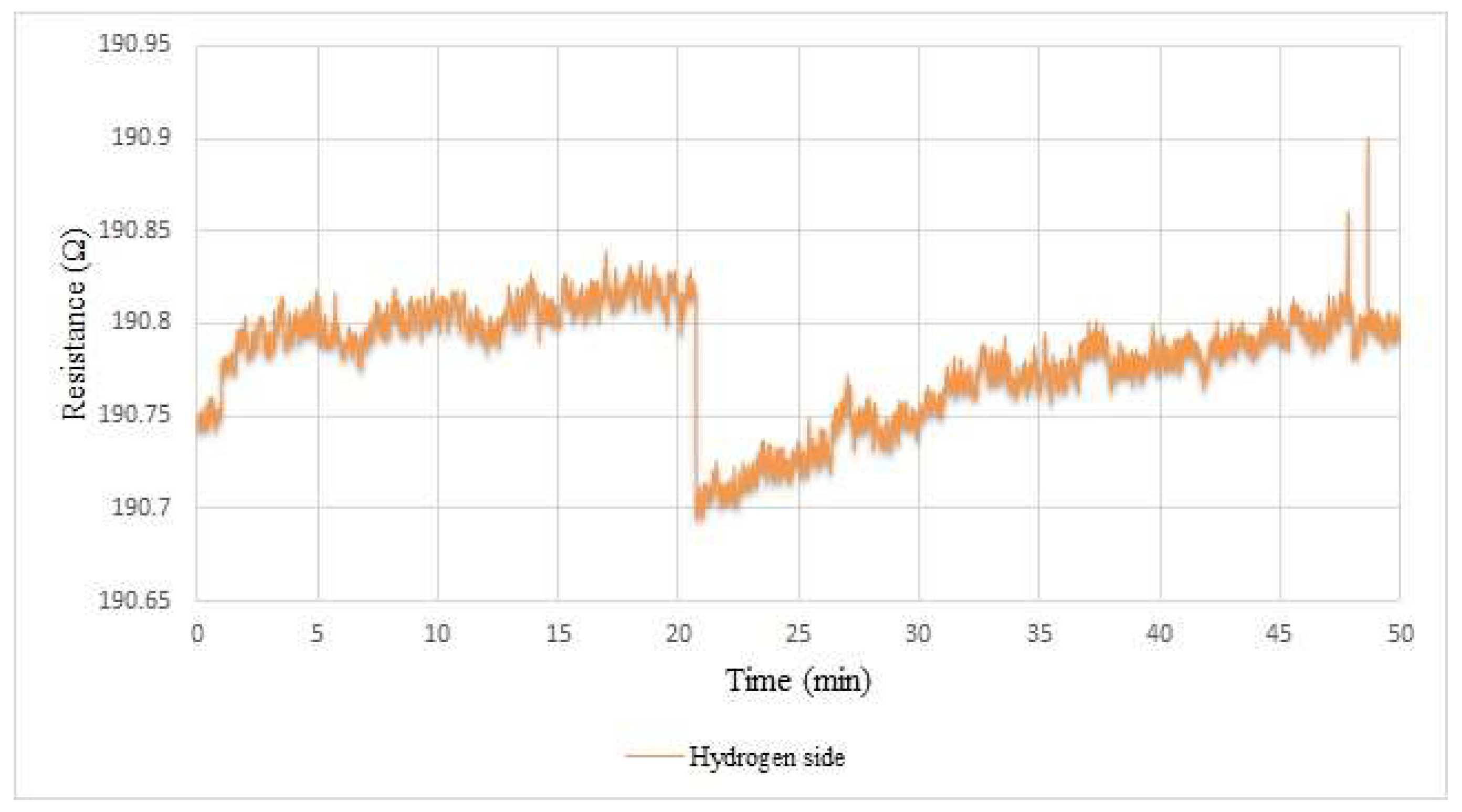
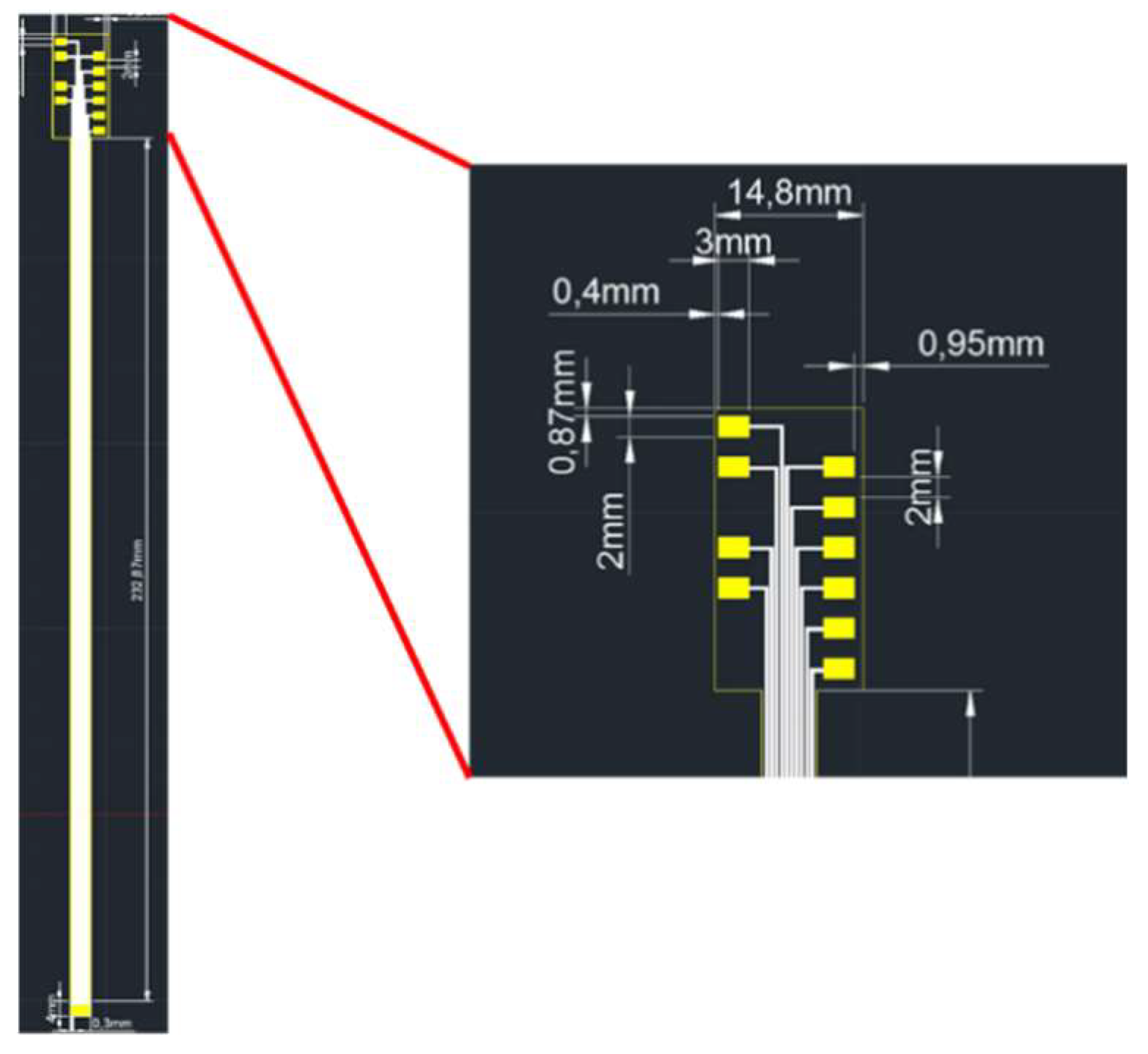
Publisher’s Note: MDPI stays neutral with regard to jurisdictional claims in published maps and institutional affiliations. |
© 2022 by the authors. Licensee MDPI, Basel, Switzerland. This article is an open access article distributed under the terms and conditions of the Creative Commons Attribution (CC BY) license (https://creativecommons.org/licenses/by/4.0/).
Share and Cite
Lee, C.-Y.; Chen, C.-H.; Chien, Y.-H.; Huang, Z.-Y. A Proton Battery Stack Real-Time Monitor with a Flexible Six-in-One Microsensor. Membranes 2022, 12, 779. https://doi.org/10.3390/membranes12080779
Lee C-Y, Chen C-H, Chien Y-H, Huang Z-Y. A Proton Battery Stack Real-Time Monitor with a Flexible Six-in-One Microsensor. Membranes. 2022; 12(8):779. https://doi.org/10.3390/membranes12080779
Chicago/Turabian StyleLee, Chi-Yuan, Chia-Hung Chen, Yun-Hsiu Chien, and Zhi-Yu Huang. 2022. "A Proton Battery Stack Real-Time Monitor with a Flexible Six-in-One Microsensor" Membranes 12, no. 8: 779. https://doi.org/10.3390/membranes12080779
APA StyleLee, C.-Y., Chen, C.-H., Chien, Y.-H., & Huang, Z.-Y. (2022). A Proton Battery Stack Real-Time Monitor with a Flexible Six-in-One Microsensor. Membranes, 12(8), 779. https://doi.org/10.3390/membranes12080779





